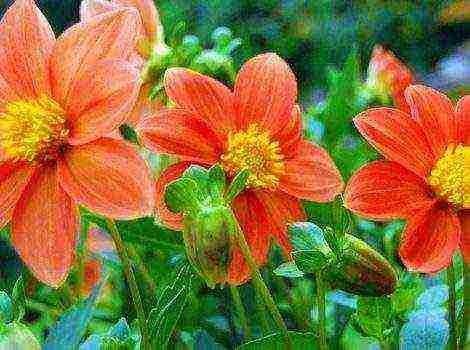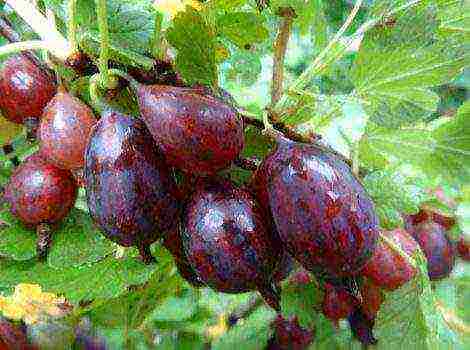Content
- 1 Winter varieties of apple trees
- 2 Useful videos
- 3 Zaluchenie
- 4 Winter varieties of apple trees with photos and descriptions
- 5 The best winter varieties of apple trees for the Moscow region
- 6 The latest varieties of winter apple trees
- 7 Why are late apple varieties good?
- 8 Idared
- 9 Antaeus
- 10 Bogatyr
- 11 Jonathan
- 12 Lobo
- 13 Mac
- 14 Red Delicious
- 15 Renet Simirenko
- 16 Sinap Orlovsky
- 17 Nuances of growing late apple trees
- 18 Late varieties for central Russia
- 19 Frost-resistant varieties for the Urals and Siberia
- 20 Winter apple trees for Belarusian gardeners
- 21 Late apple varieties of Ukraine
- 22 Table: top 10 longest shelf life apples
- 23 Gardeners reviews
 Considering that the natural conditions of our region do not allow growing fresh vegetables and fruits all year round, an important problem is the safety of grown products until the next harvest. And winter varieties of apples will help in solving this problem.
Considering that the natural conditions of our region do not allow growing fresh vegetables and fruits all year round, an important problem is the safety of grown products until the next harvest. And winter varieties of apples will help in solving this problem.
Late apples ripen and pour slowly, accumulating vitamins, and during the ripening period, the proportion of aromatic substances increases, therefore, they are much healthier and tastier than early-ripening apples.
To enjoy fresh apples all year round, it is necessary to select varieties apples for the garden and set aside enough space to grow good winter varieties, which in turn also differ in taste and shelf life.
Attention! Winter apples acquire their best taste and aroma during storage: after two weeks, up to a month or more.
 They can be divided into three groups:
They can be divided into three groups:
- early winter - until February;
- winter - until April;
- late winter - winter varieties with a long shelf life of fruits.
We present to your attention the best winter varieties for long-term storage.
Winter varieties of apple trees
Idared
Late winter medium-sized. Apples have a conical shape with rounded edges, apple weight - 150-190g. The main color of the fruit is green, the top color is a reddish blush. The structure is dense, the taste is juicy, sweet and sour.
Medium scab resistant. Begins to bear fruit 5-6 years after planting. Harvesting is carried out at the end of September, stored until mid-spring.
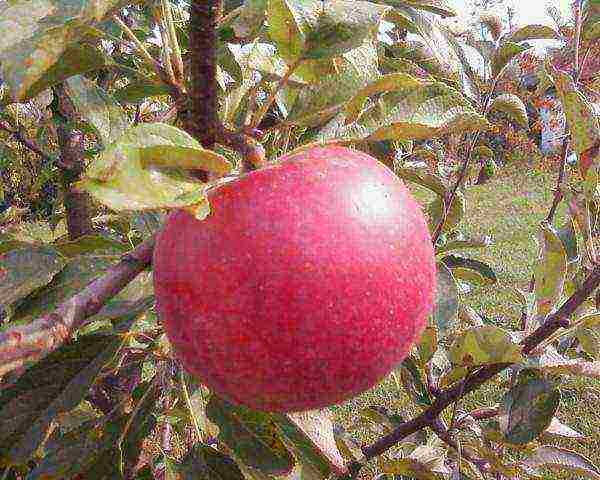
Idared.
You can see detailed photos and description of the Idared variety here.
Antaeus
Late winter sweet grade. Trees grow up to 2-2.5m.
The fruits are juicy, weighing 180-200g, have a dense, homogeneous pulp. The apples are very aromatic. They are collected in early October. When ripe, they acquire a burgundy or dark red color.
The fruits are stored until April. Apple trees have good resistance to low temperatures.

Antaeus.
You can find more information about the Antey apple tree here.
Alesya
Late winterreaching a size of 3.5-4.0 m in height. Variety early, begins to bear fruit at the age of 3-4 years. Apple tasting score 4 points. Apples are sweet and sour, juicy, weighing 150-200 g with a weak aroma and a fine-grained structure.
Differs in high productivity, regularity of fruiting, resistance to scab and adverse weather conditions. It is grown mainly on a medium-sized rootstock. Stored until May.
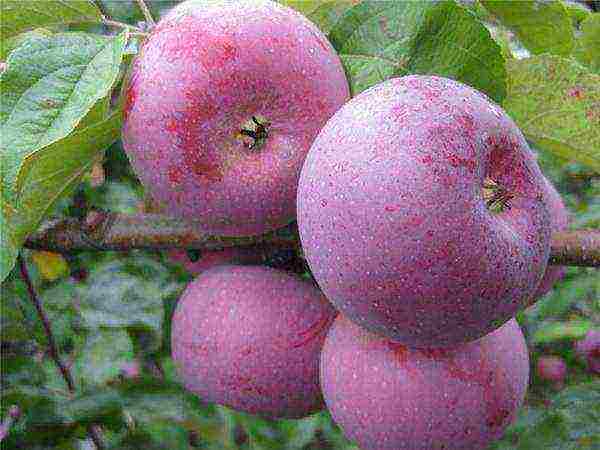
Alesya.
You will learn more about the apple tree Alesya from this article.
Antonovka
Early winter a variety of old selection. The tree is generally tall, but it is also medium-sized. The growth of a tree on a low-growing stock is 3.0-4.0 m, on a seed stock - 4.0 -6.0 m. Plants have a wide crown, branches are thick and strong. On a low-growing rootstock, it quickly begins to bear fruit.
The pale green basic color of the fruit becomes light yellow when fully ripe. Fruit weight -150-170g. The sweet and sour taste of apples has a unique wine aroma. Stored until mid-December. The pulp is juicy, dense, grainy, loosened during long-term storage.
The predominance of acidity in the taste allows it to be used in cooking and peeing apples.
It is a good pollinator for other varieties.

Antonovka.
You can read more about the Antonovka apple tree here.
Belarusian synap
Late winter grade. A medium-sized plant reaches a height of 2-2.5 m. The crown is pyramidal, not thickened. Begins to yield crops for 2-3 years.
Apples weighing 200-250 g, possess sweet and sour taste, with a pleasant juicy texture and delicate aroma. The fruits are stored until the next harvest.

Belarusian synap.
Bogatyr
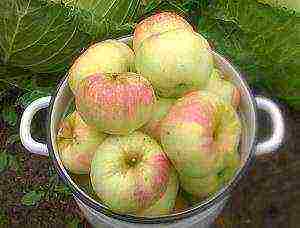 Variety refers to late winter... The taste of apples is sweet and sour. Fruits are strong, crunchy, strong, aromatic. The color is light green; during storage, it turns yellow or acquires a slight blush.
Variety refers to late winter... The taste of apples is sweet and sour. Fruits are strong, crunchy, strong, aromatic. The color is light green; during storage, it turns yellow or acquires a slight blush.
Advantages:
- winter hardy;
- drought-resistant;
- scab resistant;
- productive;
- has a good presentation;
- high transportability.
Main characteristics:
- tree growth - 2-3m;
- entry into fruiting - 5-6 years;
- apple weight - 150-190g;
- harvesting period - end of September;
- the duration of the storage of apples is until March.
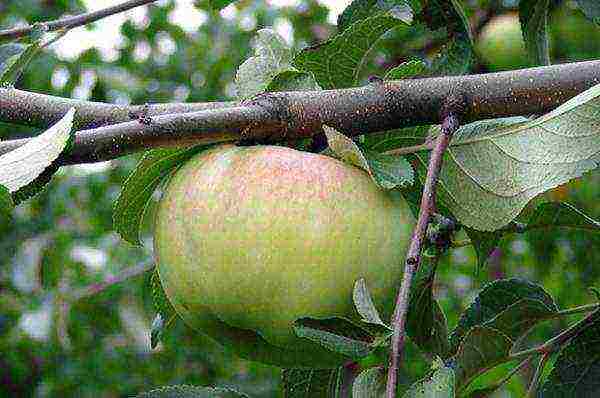
Bogatyr.
You can find more information about the Bogatyr apple here.
Golden Delicious
Late winter grade. It is cultivated with medium and vigorous rootstock. The growth of a tree on a low-growing rootstock reaches 2.0-3.0 m, on a vigorous rootstock - 4.0-6.0 m. It begins to bear fruit on a low-growing rootstock for 2-3 years, on a strong-growing rootstock - 5-6 years. The crown of the tree is wide and dense. A pollinator variety is required.
It has a wonderful sweet taste that does not get worse with prolonged storage. Apples weighing 150-200g have a slightly oblong shape and golden color. The pulp is juicy, crispy, the skin is dense, but thin, resistant to mechanical damage.
Low temperature resistance - high, transportability - good, susceptible to damage by powdery mildew and brown spot. The apples are harvested in September and stored until mid-spring.
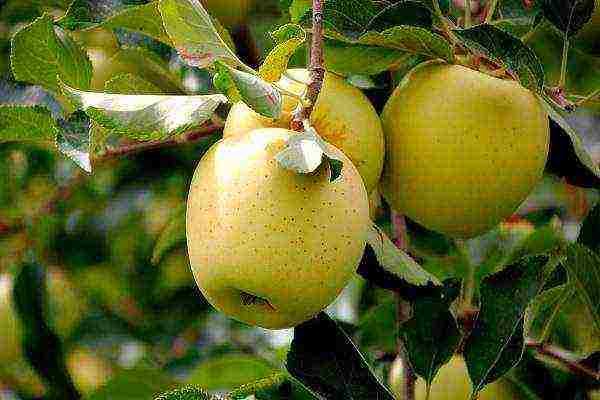
Golden Delicious.
You will learn more about the Golden Delicious apple tree in this article.
Darunak
Late winter grade. Fruits of an attractive purple color with a thin, elastic skin, slightly asymmetric, with a slight ribbing. The taste is pleasant, delicate, sweet and sour. Good resistance to low temperatures, high scab resistance and natural unpretentiousness, ease of care are its advantages.
Main characteristics:
- tree growth - 3.5-4m;
- entry into fruiting - 3-4 years;
- apple weight - 120-160g;
- harvesting period - late September - early October;
- the duration of the storage of apples is until March.

Darunak.
You can read more about the Darunak apple tree here.
Jonathan
Late winter apple variety of North American origin. Its other names: Osmalovskoe, Horoshavka winter, Winter red.
The tree is medium-sized, 2.5-3.0 m high. Prefers fertile, well-moistened soils. Has good resistance to scab and powdery mildew.
The fruits are juicy, dense, weighing 150-190g, by the end of ripening they acquire a red blush, have a sweet and sour taste and a weak spicy aroma. Tasting score 4.5 points. Fruits are stored until March.
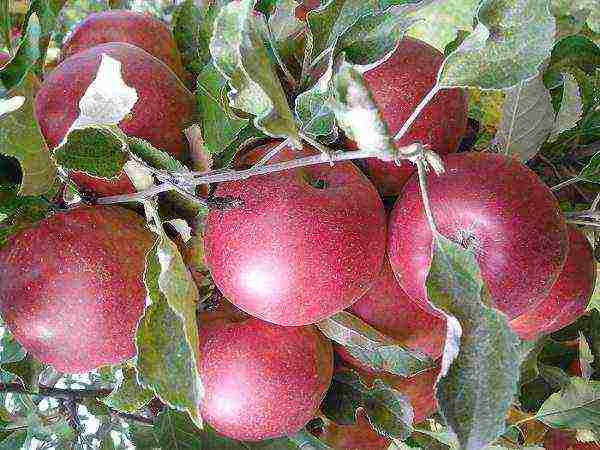
Jonathan.
Read more about the Jonathan apple tree in this article.
Lobo
An early winter variety with excellent taste characteristics. Has a high yield and annual fruiting.Among the advantages are drought resistance and winter hardiness. Fruits are juicy, dense, rounded, weighing 100-180 g, deep red.
Main characteristics:
- tree height - 3.4-4.0 m;
- the beginning of fruiting -4-5 years;
- harvesting period - late September - early October;
- the duration of storage of apples is until January.
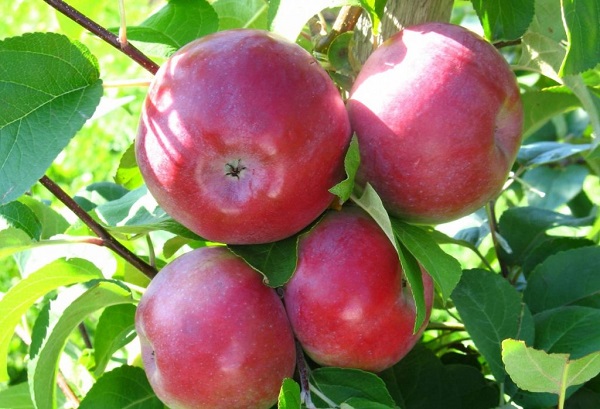
Lobo.
You can find more information about the Lobo apple tree here.
Mac
Early winter sweet variety. The main color is light yellow, covered with purple or dark red stripes on top. Ready to eat a couple of weeks after taking off. The trees have an average winter hardiness and are susceptible to fungal diseases.
Main characteristics:
- tree growth - 3.5 - 4.0 m;
- entry into fruiting - 150-180g;
- harvesting period - late September - early October;
- the duration of storage of apples is until January.
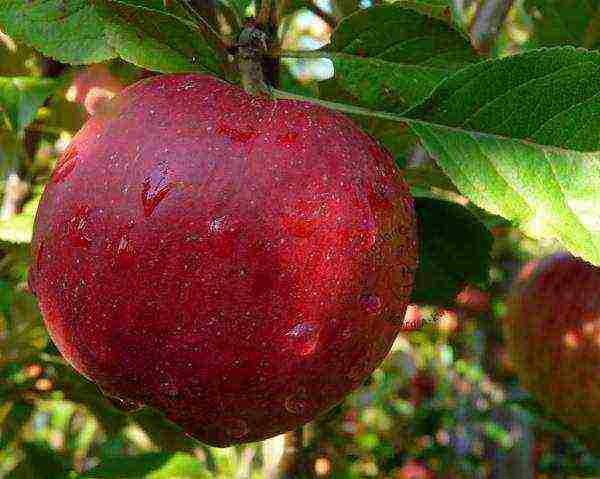
Mac.
You will learn more about the Macintosh apple variety in this article.
Pepin saffron
The oldest, most popular late winter variety in the Russian Federation. The yield is high, but fruiting in adulthood is characterized by periodicity. Begins to bear fruit in 5-6 years.
The apples are small enough, weighing 70-80g, strong, have an elongated, ovoid shape. They are ruddy on the top, and the main color is light green. The taste of the fruit is sweet, and the aroma is spicy, with a wine aroma.
Winter hardiness and disease resistance - average. Recovers quickly from damage. Harvested in late September - early October and stored until March.
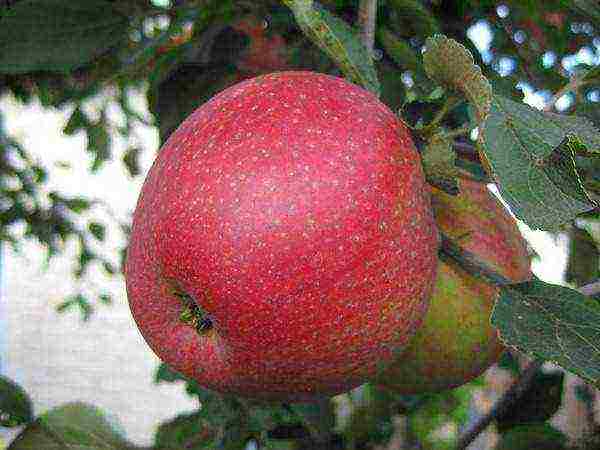
Pepin is saffron.
You can read more about the apple variety Pepin saffron here.
Red Delicious
Medium winter apple tree, reaching a size of 4.0-6.0 m. The crown is wide, slightly pyramidal, and its fruits are large. The commercial qualities are high, the transportability is good.
Apples are prized for their sweet taste. The bright red color of the fruit attracts the attention of consumers. The cleaning period is September-October. Duration of storage of apples - until February.
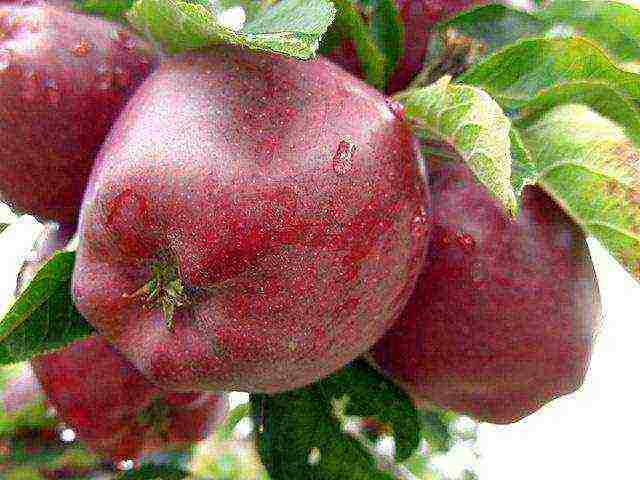
Red Delicious.
Read more about the Red Delicious variety in this article.
North synap
Late winter variety with a wide, powerful, pyramidal crown. Medium-sized tree... High yield, average drought resistance and scab resistance are the dignity of the variety. In addition, the North Sinap is a winter-hardy apple tree variety. Harvesting maturity occurs relatively late - by the beginning of October.
Advice! Unripe apples do not provide high taste, therefore, harvesting must be carried out when the fruits acquire a beautiful appearance and a ruddy casing color and are fully ripe.
Main characteristics:
- tree growth - 4.0-6.0 m;
- the beginning of fruiting - 6-8 years;
- apple weight - 120-170g;
- harvesting period - late September - early October;
- the duration of storage of apples is until April.
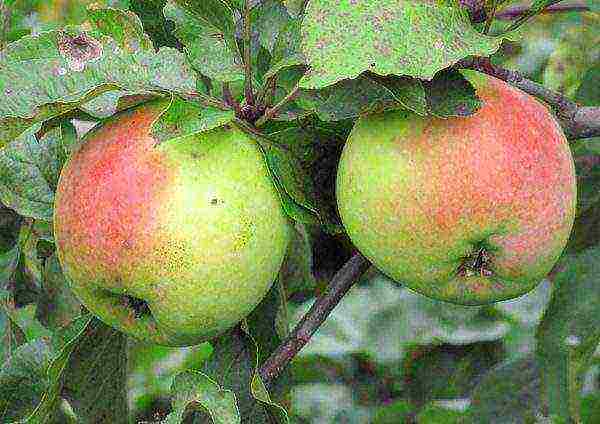
North synap.
You can find more information about the North Synap apple tree here.
Sinap Orlovsky
Variety winter, with a tall wide crown, reaching - 3.0-4.0 m. Fruits are green with a slight blush, large, weighing 200-250 g, the same size, have a good presentation. The pulp is dense, juicy, sweet, with a slightly perceptible sourness.
Possesses good resistance to difficult weather conditions and diseases. The crop is harvested at the end of September and store until March.
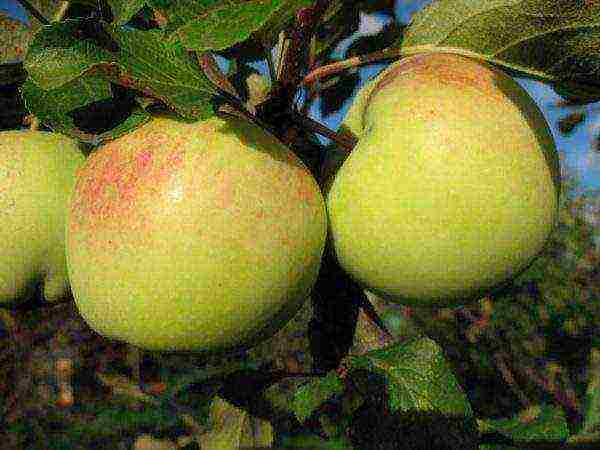
Sinap Orlovsky.
You will learn more about the Sinap Orlovsky apple variety in this article.
Useful videos
Watch a video with a brief description of the winter varieties of apple trees:
Watch a video review of the apple tree expert Golden Delicious:
Watch a video of what the Lobo apple tree looks like:
Watch a video of what the North Synap apple tree looks like on a dwarf rootstock:
Zaluchenie
Growing winter varieties of apples allows not only to extend the shelf life, but also preserve the unique taste and aroma of fruits and their nutritional value.
Later dates of harvesting apples of winter varieties will allow rational planning of autumn work and free up time for processing the harvest.
And rememberamong winter apple trees there are frost-resistant varieties, but not all of them are!
Most of the orchard of most summer residents and gardeners are apple trees. They grow best in mild climates. Despite this, they can be grown in less favorable weather. The most common are the winter varieties of apple trees.
Among the advantageous properties, resistance to low temperature conditions and, of course, a rather long period of storage of fruits are noted. Depending on the variety type, a person can enjoy fresh fruits all winter, from about 4 to 8 months they do not lose their qualities. The maximum border in this regard is the beginning of July. At this time, the early species of this fruit are already ripening. In other words - growing early and late apples, you can eat them all year round. But you should definitely adhere to the appropriate storage rules and temperature conditions. It is noteworthy that during storage, fruits do not lose their taste properties, as well as the level of starch and protopectin (a substance that allows you to establish the functionality of the body by removing toxins and harmful compounds).
Since the birthplace of this tree is a temperate zone, the largest apple-producing countries are located in this climatic zone (Germany, France, Ukraine, Italy, Russia, England, Poland, as well as the USA and China). It is here that the best winter varieties of apple trees are bred and rich harvests are collected.
Winter varieties of apple trees with photos and descriptions
Almost all varieties of winter apple trees (see photo with the name) have an excellent aroma, and it can be preserved for a long time. The peel of all winter-hardy fruits is much thicker than that of early and mid-early fruits. This also applies to the pulp - it is harder. These features provide resistance to damage, prevent decay processes, which means that the quality of the fruit is ensured even during long-term storage.
It should be noted that winter varieties of apple trees (reviews of experienced summer residents confirm this) are not always suitable for human consumption, if they are only plucked from the tree. Fruits do not yet have such a rich taste, and many of them can be sour. The period of full ripening begins in about 4-7 weeks, the fruit should be well laid down.
The hardy species of these fruit trees are classified into three categories:
- Early winter... The approximate shelf life dates from the end of February (Pepin Shaffranny, Uelsi, Winner, Antonovka ordinary, Winter gold Parmen).
- Average winter... You can eat the fruits until the beginning of May (Aport, Lobo, Anis Seryi, Antonovka dessert, Ranet, Sinap Orlovsky, Mirnoe, Kortland).
- Late winter... According to the shelf life, they are the most stable, they can lie until the beginning of July (North Sinap, Mantuan, Renet Orleans, Sarah Sinap).
The best winter varieties of apple trees for the Middle Lane:
- Jonathan... This is an American selection known to gardeners as Winter Red. A scarlet blush covers the fruits of medium-sized trees almost completely closer to harvest. Jonathan apples are delicious. After planting a young tree in the soil, a bountiful harvest can be expected in four years. Such winter varieties of apple tree seedlings do not exceed 3-3.5 m in height. On average, the fruits have about one and a half hundred grams of weight. The approximate shelf life is 160 days.
- Semerenko... One of the best varieties of winter-hardy apple trees of Ukrainian selection. Named after its creator, breeder L.P. Semerenko. The main property is the preservation of taste and original aroma even after long-term storage. The deadline is 6 months. At the end of this period, the apples may lose their shape slightly and become a little sluggish. As for the yield, summer residents harvest on average 60 to 100 kg. fruit from the apple tree. Winter varieties are in great demand in Ukraine. Fruit color is rich green.It is preserved throughout the entire ripening period. During storage, the fruit may acquire a mild yellowish tint. The shape of the apples themselves is round, slightly flattened at the poles.
- Antaeus... Belongs to the category of late winter varieties of apple trees. Belarus is the birthplace of Anthei. The description says that trees can tolerate fairly low temperatures. The fruits are juicy and have an incomparable taste. During the growing season, they change their color from bright green to burgundy. A notable feature is the presence of a waxy coating on the skin of the fruit, which gives it a slightly bluish tone. Antey apples are fully ripe 8 weeks after harvesting. An adult tree does not exceed 2.5 m in height. It is very convenient to pick weighty fruits (about 0.2 kg. Each) from a tree. When stored properly, the fruit can be eaten until mid-summer.
- Winter Beauty... This is the result of the work of Russian breeders (authorship belongs to amateur breeder Kamendzhrovsky E.M.). Fine fruits have a rich taste and mild aroma. In large fruits, which can reach from 180 to 400 gr. weight, the best qualities of two varieties are combined - this is Red Delicious and the favorite of many gardeners, Antonovka ordinary. It was on their basis that a wonderful variety of apple trees, Winter Beauty, was created. The description of these winter-hardy apples characterizes it on the positive side. They are endowed with excellent properties and have a dessert taste, have a long shelf life, and are very resistant to winter cold. The fruits have a bright green color, which then acquire a delicate yellow tint. The apples are rounded with a slightly elongated bottom. This variety thrives best in the Northwest and Central regions.
- Mac... We can say that this is the most unique variety of winter apple trees. Red fruits in the form of a balloon ripen, practically, earlier than all winter-hardy varieties. This is the result of the work of Canadian breeders. Macintosh has an unsurpassed taste, which can be fully enjoyed no earlier than a month after harvesting the fruit. The trees are quite tall - 3.5-4.5 m. The average weight of the fruit is about one and a half hundred grams.
- Antonovka... The most popular apple tree. Winter resistant varieties like this one do not have such a bright zest that Antonovka has - a sour taste that only emphasizes its unsurpassed taste. The apples are very aromatic, tasty and bright. It is impossible to confuse them with any other species. Its fruits are yellowish-creamy. They are quite weighty (200-300 g). Among the advantageous properties, it should be noted excellent frost-resistant characteristics and a long shelf life.
- Winter lungwort... Belongs to the autumn-winter varieties of apple trees with an average ripening period. Young seedlings can yield a harvest as early as 4 years after rooting in the main soil. Fruits are harvested at the beginning of October. Up to one centner of ripe fruit can be harvested from one mature tree. Apples are stored until early March. The apple variety Winter Medunitsa tolerates frost very well. An insignificant drawback can be considered a slight loss of taste at the end of the scheduled storage period. The taste of ripe and matured (about 5 weeks) apples can be described as fresh sweet with medium juiciness.
- Bogatyr... One of the most versatile winter varieties of apple trees. For Siberia, for the Urals and for the entire Middle Belt, there is no better option. It belongs to the late winter category and is one of the most popular among summer residents and gardeners. The Bogatyr sapling can withstand very low temperatures, so it is suitable even for northern latitudes. The shade of strong, firm and aromatic fruits is light green. Ripe apples may develop a slight red blush. Fruiting very early. Harvesting can be done at the end of September.The fruits have an average weight of 0.2 kg. Mature trees are slightly taller than a person, which ensures an unhindered and high-quality harvest of ripe apples. The taste of the fruit is predominantly sweet, a slight sourness is felt.
The best varieties of winter apple trees are also:
The best winter varieties of apple trees for the Moscow region
Experienced gardeners of the Moscow regions allocate about 50% of the garden area for winter-hardy varieties of apple trees. This is due to the special climatic conditions of this region. The criteria for choosing winter varieties of apple trees for the Moscow region are characterized by the endowment of such qualities as disease resistance, fruiting period, frost resistance, and yield. In this regard, some of the best apple trees are:
Also, special emphasis is placed on the columnar shape, especially in those areas, the area of which is limited. As a rule, the columnar shape can be grafted into any variety. This is done by grafting cuttings of any compatible variety. The best winter varieties of columnar apple trees for the Moscow region with a photo:
The latest varieties of winter apple trees
No matter how good the classic and popular varieties of winter-hardy apple trees are, summer residents and gardeners are looking for new items. Breeding work does not stop. The result of the work of agricultural enterprises and private gardeners is new products that are rapidly gaining popularity and are being successfully grown. These are the latest varieties of winter apple trees:
In addition to these new products, there are the following varieties of winter-hardy apple trees: Toshiro Fuji (China), Evelina (Russia), Beni Shogun (USA), Rubinette-Katerina (Ukraine).
If we talk about practical tips for choosing a fruit tree for growing in your garden, then in addition to studying theoretical material, you need to independently evaluate the taste of apples and determine whether they match your preferences.
It is generally accepted that red is the only sign of a ripe fruit. However, most often only winter varieties of apple trees can please with this color. Which of the late varieties are the tastiest?
Choosing winter seedlings, or, as they are also called, late apples, there are several important factors to consider. Winter apples do not acquire their optimal taste immediately after harvest, but within a few weeks or even months after harvest. In addition, the trees of such apple trees have increased winter hardiness and can easily endure both severe frosts and recurrent cooling after a thaw.
Why are late apple varieties good?
The main distinguishing feature of late apples is increased keeping quality... They are perfectly preserved until spring (some varieties are stored until summer) and at the same time do not lose their original taste and aroma. They are usually removed in late September - early October in the phase of removable maturity. The fruits at this time contain a lot protopectin and starch... During ripening, the proportion of coloring and aromatic substances in them increases.
Late apples become completely ready for consumption after a few months. Their shelf life, depending on the variety and environmental conditions, ranges from 4 to 8 months.
Benefits later varieties of apples are:
- long shelf life;
- apples ripen and acquire a stable taste and aroma;
- dense texture and firm rind;
- good transportability;
- suitability for any kind of processing.
Late apple varieties are also differentiated by shelf life by:
- early winter (Antonovka ordinary, Winner, Pepin saffron, Parmen winter gold, Welsey) - stored until January-February;
- winter (Anise scarlet, Anise gray, Antonovka dessert, Aport, Kortland, Lobo, Mirnoe, Ranet bergamot, Northern Sinap, Sinap Orlovsky) - stored until March-April;
- late winter (Mantuan, Sary Sinap, Renet Orleans, Renet Champagne, North Sinap, etc.) - stored until May-June.
The main difference between winter and summer varieties of apples is that they are undesirable to eat right away - they must lie down for at least a month.
Idared
Late winter tall variety. Fruits are slightly conical in shape with small blunt or slightly angular ribs. Initially, they are green, when exposed to the sun, they are covered with yellow and red blush. The taste is pleasant, with a dense and juicy pulp. The variety is resistant to brown spot, but susceptible to diseases of powdery mildew and scab. They are consumed not only fresh, but also used to prepare compotes, dried fruits and juices.
| Entering fruiting | Tree height (m) | Fruit weight (g) | Harvest | Shelf life (days) | |
|
For 5-6 years |
2-3 |
150-190 |
End of September |
150-180 | |
Antaeus
A late variety of apples obtained by Belarusian breeders. Possesses increased frost resistance and perfectly tolerates even the most severe winters. Juicy and sweet fruits do not lose their aroma for a long time. As they ripen, they change color from green to bright red and burgundy. They often have a waxy coating that gives a bluish tint. The consumer ripeness of the fruit occurs 2 months after picking. They can be consumed both fresh and harvested for future use.
| Entering fruiting | Tree height (m) | Fruit weight (g) | Harvest | Shelf life (days) | |
|
2-3 years |
2-2,5 |
180-200 |
Second half of September - early October |
200-240 | |
Bogatyr
A variety that bears fruit in almost any climatic zone. It was created as late winter, the fruits are very hard and strong, under good conditions they can lie until the end of May. They have a pleasant sweet and sour taste. Until harvesting, the color of the fruit remains light green, during maturation, they turn yellow, and sometimes become covered with a red blush. The advantages of the variety include early fruiting, scab resistance, excellent presentation of fruits, transportability, excellent taste and a consistently high yield.
| Entering fruiting | Tree height (m) | Fruit weight (g) | Harvest | Shelf life (days) | |
|
For 5-6 years |
2-3 |
150-190 |
End of September |
150-180 | |
Jonathan
This late winter American variety has other names: Winter red, Horoshavka winter, Oslamovskoe. The trees are medium-sized, give a good harvest only on fertile, sufficiently moist soil. The variety is relatively resistant to powdery mildew and scab. The fruit tastes great. By the end of ripening, a red blush covers almost all of their surface.
| Entering fruiting | Tree height (m) | Fruit weight (g) | Harvest | Shelf life (days) | |
|
For 4-5 years |
2,5-3 |
110-150 |
Mid september |
150-180 | |
Lobo
Daughter variety of Macintosh, which inherited the best taste and rich red color from it. The yield of the variety is above average. It bears fruit annually, while the number of apples is constantly growing. It has good winter hardiness and drought tolerance. Disease resistance is average.
| Entering fruiting | Tree height (m) | Fruit weight (g) | Harvest | Shelf life (days) | |
|
For 4-5 years |
3-4 |
100-180 |
September 25 to October 5 |
150-180 | |
Mac
A unique Canadian variety, which is believed to have been bred from the only apple tree that survived in the garden. The main color of the fruit is whitish-yellow or green, the integumentary color is presented in the form of purple or dark red stripes. The fruits ripen 2-3 weeks after harvest. Sometimes, after long-term storage, apples are used for harvesting for future use, but their main purpose is fresh consumption. The taste is moderately sweet and full-bodied. Average winter hardiness, low scab resistance.
| Entering fruiting | Tree height (m) | Fruit weight (g) | Harvest | Shelf life (days) | |
|
6-7 years old |
Up to 4 |
150-180 |
Second half of September - early October |
150-180 | |
Red Delicious
The tree is medium-sized, at a young age the crown looks like an inverted pyramid, and then becomes rounded or wide-round. The fruits, as they ripen, acquire a bright red, rich color.The taste is sweet with a slight iron flavor. They store well and tolerate transportation. Their only drawback is frequent damage by bitter spot during storage.
| Entering fruiting | Tree height (m) | Fruit weight (g) | Harvest | Shelf life (days) | |
|
3-4 years |
3-4 |
200-250 |
End of September |
180-210 | |
Renet Simirenko
The exact origin of this mixed-fruiting winter variety is unknown. The trees are usually taller than average and tolerant of drought and high winds. The fruits are medium and large in size. Their main color is light or bright green. A distinctive feature of the variety (and not a disease) are warty formations with a diameter of 7 mm with rust on the surface. Their number can reach 2-3 per fruit. The pulp is white, tender and juicy, with a wine-sweet spicy aftertaste. The fruits are consumed mainly fresh.
| Entering fruiting | Tree height (m) | Fruit weight (g) | Harvest | Shelf life (days) | |
|
For 4-5 years |
Up to 6-7 |
140-170 |
End of September - beginning of October |
230-250 | |
Sinap Orlovsky
Late winter grade. Trees are large in size, so when setting up a garden, you need to allocate enough space for them. The fruits grow large, almost the same size. The general color of apples is green, with a red blush in places. The pulp is sweet with a slight sourness. For good growth and fruiting, calcium must always be present in the soil.
| Entering fruiting | Tree height (m) | Fruit weight (g) | Harvest | Shelf life (days) | |
|
For 4-5 years |
6-8 |
130-150 |
Last decade of September |
200-240 | |
Winter apple varieties have a long shelf life, have a strong structure and an attractive appearance. With proper cultivation, they give a rich harvest and can remain intact until almost mid-summer.
Winter-ripening apple trees are unique in that their fruits are stored the longest and will provide your family with vitamins for the whole winter and spring. Healthy, fragrant and vibrant fruits will only be available if the seedlings have been properly selected and grown. The beginning of the search lies in the list of varieties specially bred or adapted to different regions.
Nuances of growing late apple trees
The most significant events for fruit trees are:
- Landing.
- Care.
- Pruning.
Let's take a closer look at each item.
Landing
Violation of the planting rules leads to the fact that the tree will bear little fruit or may even die. The process is divided into three important stages:
- Choosing a place and a seedling.
- Preparation of the landing pit.
- Directly landing.
Several factors will influence the choice of apple trees for your garden. To choose the right variety, you need to understand:
- the height and type of tree (tall or medium-sized, dwarf or columnar);
- ripening time of apples;
- illumination of the place under the apple tree;
- shelf life and taste of the fruit.

When choosing an apple tree seedling, you need to take into account the condition of the soil (including the level of groundwater), and the place for planting, and many other factors
If the seedling is chosen incorrectly, most likely it will simply die.
After the specific variety has been identified, they proceed to the preparation of the pit. Experienced gardeners will take care of this in advance. Recommended timing:
- for planting in autumn - July - August;
- spring - September - October.
It is better to plant any apple trees in the fall, but this is especially important for winter varieties.
After leaf fall, a dormant period begins at the top of the plant and the tree spends energy only on the development of roots. It is stocked with nutrients that freely flow to the roots with autumn rains. It is then that the apple trees take root very well. The optimal time is when the soil temperature is not lower than + 4 ° C, but the Indian summer has already ended. Long daylight hours can awaken the buds and bring the tree out of the state of biological dormancy. Therefore, most often apple trees are planted in the second half of September.The tree will take 10 to 25 days for it to take root and gain strength for the spring growing season.
The soil substrate for planting is prepared taking into account the peculiarities of the soil of the place where the tree will grow.
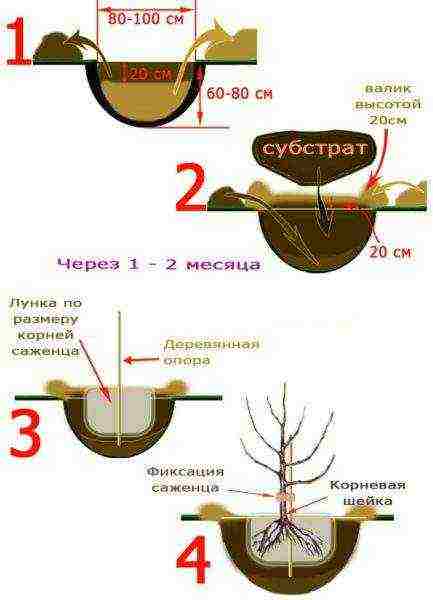
For apple trees, it is very important to properly prepare the planting site in advance and act strictly according to the given scheme
While the pit under the apple tree is infused, the earth settles. At this time, siderates are often planted, which are then simply dug up along with the soil.
When filling an apple tree seedling with a substrate, it is important to remember that the root collar should not be buried. At the end, the plant is watered abundantly and the trunk circle is mulched.
Careful preparation of the planting site is especially important for open-rooted seedlings. But regardless of whether there was a tree in the container or without, for him in the next two or three years, those elements that are embedded in the substrate are very important. It is they who will give the apple tree strength for growth and proper development.
Table: timing of planting seedlings, depending on the region
If the deadlines for planting apple trees in the ground in autumn are observed, it is important to focus not only on the weather forecast, but also to follow nature. We need the last days of leaf fall.
Care
In general, winter varieties are looked after in the same way as others, but there are some peculiarities. For example, autumn spraying. From the point of view of the prevention and treatment of diseases, this is an important point in tree care. It is carried out only after the fruits have already been harvested. Late ripening varieties yield in September-October, which means that spraying should be done later. But at this time, the autumn weather comes into its own. Rain, a drop in temperature, and even more so frost will not allow such processing. Therefore, it is very important not to skip the spring spraying.
Video: pruning fruit trees for beginners
Late varieties for central Russia
The large amplitude of average annual temperatures in the Moscow, Smolensk, Tver, Nizhny Novgorod regions complicates not only the planting conditions, but also the very choice of seedlings. But these 5 varieties will never disappoint gardeners.
- Late winter North Synap is a tall, vigorous plant with a dense, beautiful crown, shaped like a cone.
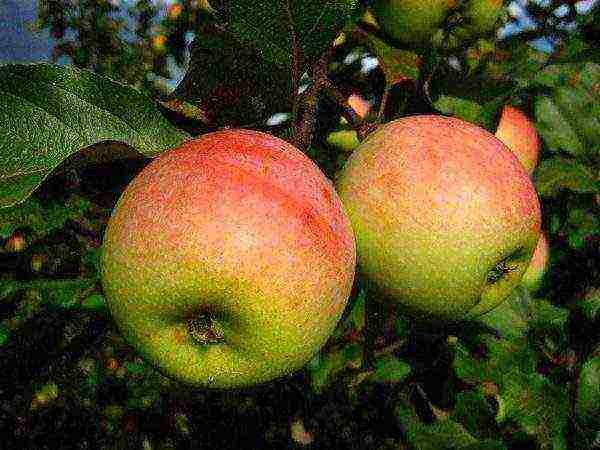
The light flesh of the Northern Sinup will surprise you with an incredible spicy-sour taste with a sweetish aftertaste, and the golden-lime color, decorated with a burgundy-raspberry blush, will delight the eye
- In early October, vigorous Bolotovskoe apple trees yield an average of 160 c / ha.
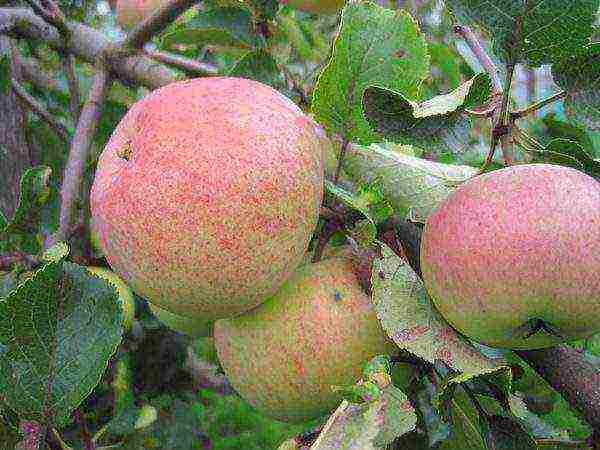
Pale red Bolotovski apples taste sour with gradually revealing sweetness
- The tall tree of the Lobo table variety has earned the love of gardeners for a stable harvest, a compact rounded crown, rapid development and growth.
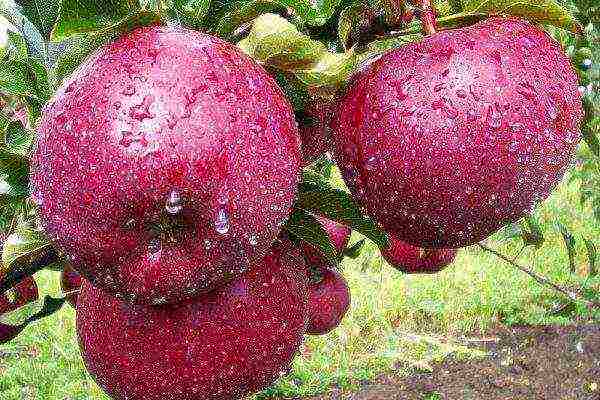
Lobo apples, sour with a characteristic sweet aftertaste, when ripe, acquire a beautiful carmine-raspberry color with a barely noticeable bluish sheen
- The recently bred September variety Imrus looks like a medium-sized tree with a rounded crown.
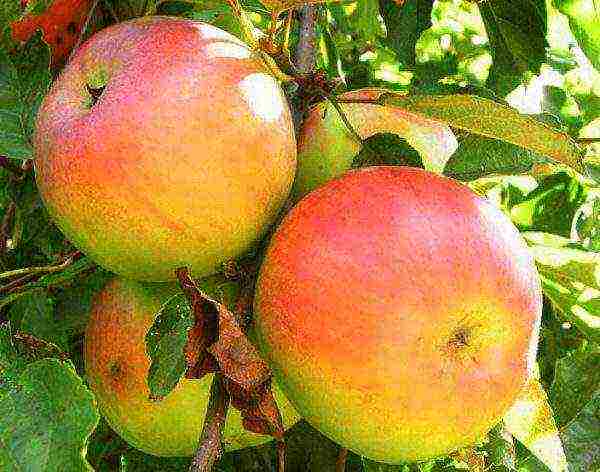
The fruits of the Imrus variety are sunny-green in color with a beautiful dark pink blush, have a sweetish taste with a pleasant sour aftertaste
- Freshness is not only a medium-sized tree with a beautiful sparse crown, but also a stable yield of 111 c / ha. The variety is late winter in terms of consumption.
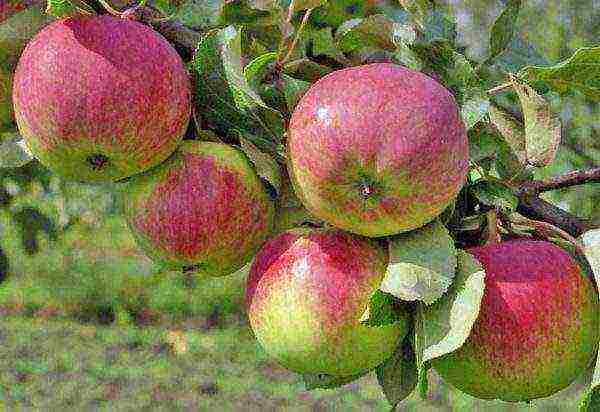
Apple trees of the Freshness variety have small fruits of a light emerald color with an unusual streaky blush of a pale red color, the taste is sweet with a pronounced sour aftertaste
Table: frost resistance, yield and other features of middle lane apple trees
Gardeners of central Russia will also be interested in varieties:
- Veteran;
- Blagovest;
- Bogatyr;
- Pepin Saffron;
- Aphrodite.
Apple trees of Moscow region
The following varieties have become the most popular among gardeners of the Moscow Region.
- Orlovskaya Zarya won the love of gardeners with its rapid development.The plant itself is medium in height and in the shape of a not very dense crown resembles an inverted pyramid.
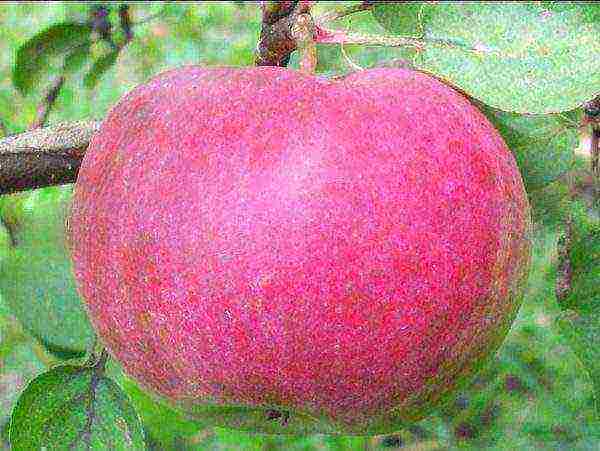
Fragrant apples of the Oryol dawn, carmine-raspberry in color, very juicy, characterized by an exquisite sweetish taste with a subtle hint of acid
- Imant is a late winter variety, a powerful tree, but medium in height. The crown of the plant is dense, conical.

Beautiful matte apples of the Imant variety have a juicy, crunchy sweet and sour pulp
- The sun is a tree with a rounded crown, up to 3-4 meters high.

The color of the Solnyshko variety is really sunny, with a beautiful transition from light golden to reddish-pink, the taste of the fruits is sweet and sour
- One of the most unpretentious table varieties of apple trees is the incredibly productive Bogatyr. This is a tall apple tree with a wide, rounded-conical crown of medium density.
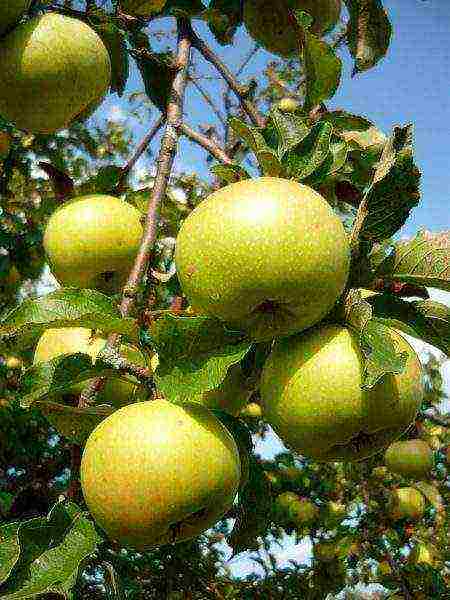
Crispy apples of the Bogatyr variety have a beautiful golden-green color, a slight blush is allowed, the pulp is white, sour with an unusual sugar flavor
- The fast-growing Veteran is a medium-sized winter variety with a thin crown.
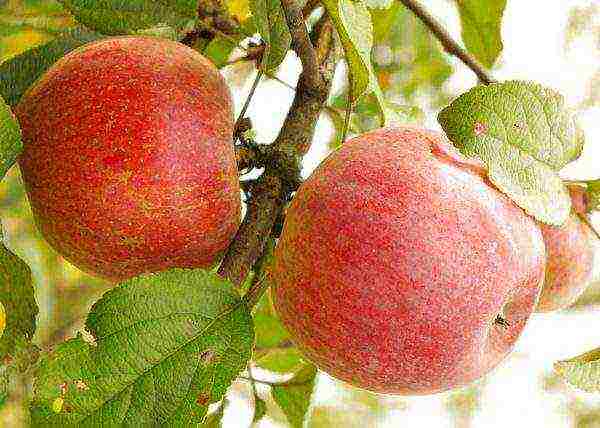
Veteran's fruits have a pleasant sourish-sugar taste and an unusual color, smoothly transitioning from bright golden to red-carmine, while burgundy strokes are clearly visible on the skin of the fruit
Table: the main features of the varieties near Moscow
In the gardens of the Moscow Region, varieties such as:
- Star;
- March;
- Orlik;
- Rozhdestvenskoe;
- Spartan.
Frost-resistant varieties for the Urals and Siberia
Gardening is not easy in cold regions. But those who have made up their minds will find the most delicious, popular and interesting varieties of winter apple trees.
- When the breeders crossed the Peach and Kungur pineapple apple trees, no one could have imagined that such an unusually tasty and winter-hardy variety like Persianka would turn out. An adult plant of medium height with a very compact crown of a regular-rounded shape.
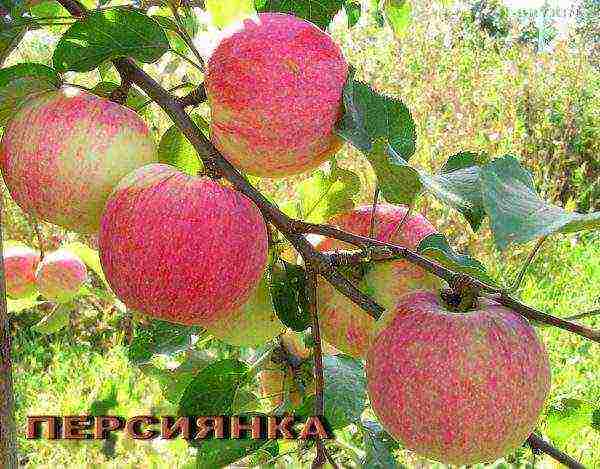
The light golden fruits of the Persian woman are decorated with a delicate pale reddish streaked blush, very juicy and sweet-sour to taste.
- The Bashkir handsome variety is a medium-sized tree, with a beautiful spreading crown, in the shape of a pyramid. One of the advantages of this variety is the extended period of consumption: from late autumn to early winter.

The fruits of the apple tree Bashkir handsome of a bright carmine-red color, with beautiful strokes on a blurred background, the taste is spicy-sweet with a pleasant sour aftertaste
- The high-yielding variety Bratchud can be either dwarf up to one and a half meters, and medium-sized (up to 3 m high), this feature completely depends on the stock.

Bratchud's fruits are light green-golden with a bright burgundy-purple blush, the pulp is light and coarse-grained, sour in taste, with a light, gradually revealing sweet note
- Early winter Arkaim is a medium-sized apple tree with relatively fast growth and a dense spreading crown.
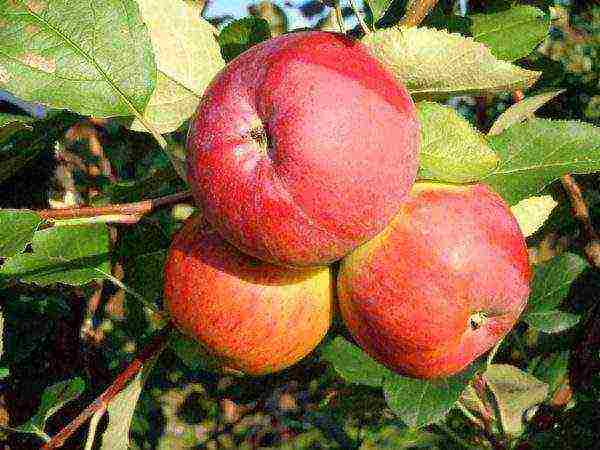
Arkaim fruits have a pleasant spicy-sour taste with a long sweet-sugar aftertaste and pleasant coloration - a beautiful transition from emerald-golden to brick-red
- The universally applicable variety Orenburgskoe later is a short tree with a fancy rounded-spreading crown, dark emerald in color.

The aromatic burgundy-red apples of the Orenburgskoye variety later combine both a juicy sweet-sour taste and good marketability
Table: unique properties of apple trees for the Urals and Siberia
For the weather conditions of the Urals and Siberia, varieties such as are also suitable:
- Symbol;
- Kibo;
- Altynai;
- North Synap;
- Bogatyr.
Winter apple trees for Belarusian gardeners
Although the western climate of Belarus is more favorable to fruit and berry trees, gardeners still need to be careful and carefully select apple varieties. For the conditions of this country, the following 5 options are ideal.
- The Vesyalina variety is a medium-sized tree with a not very dense, rounded crown.
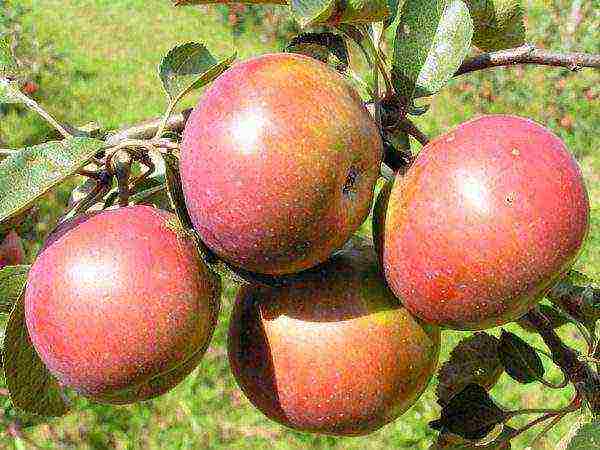
The sour fruits of Vesyalina have a delicate sweet aftertaste and rich aroma, decorated with a rich crimson blush.
- Antey has medium-sized, slightly pubescent brownish shoots. The height of this apple tree rarely exceeds 3 m. It is interesting that the crown, with a low density, grows in tiers, therefore, it can be formed at will.

Fruits of the Antey variety are delicate emerald with a characteristic dark pink blush and a pleasantly sour taste
- The world famous Wesley, or Tartu rose, differs from other early winter varieties not only in self-fertility, but also in the extraordinary dessert taste of the fruit. The Wesley plant itself is a medium-sized tree with a spreading, rounded crown.
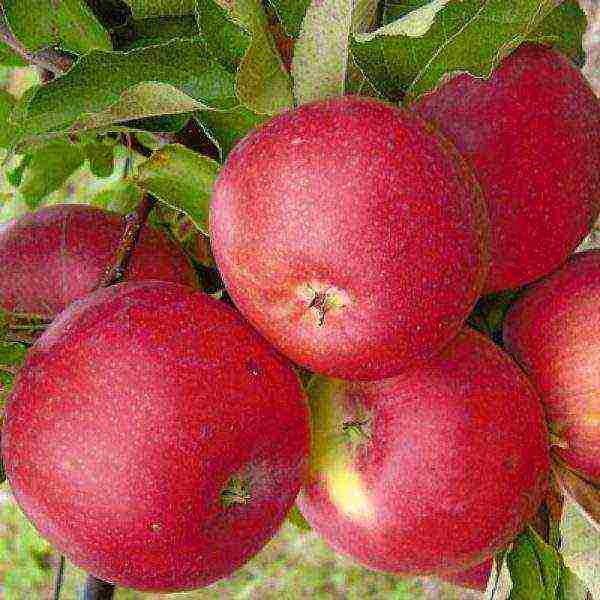
Dark-burgundy, like a ripe cherry, with a characteristic streakiness, the color of Wesley's fruits seems to turn into an extremely juicy pulp with a pleasant sourness, which has veins of a pale red hue
- The table Belarusian synap is a tall apple tree with a gorgeous sparse crown.
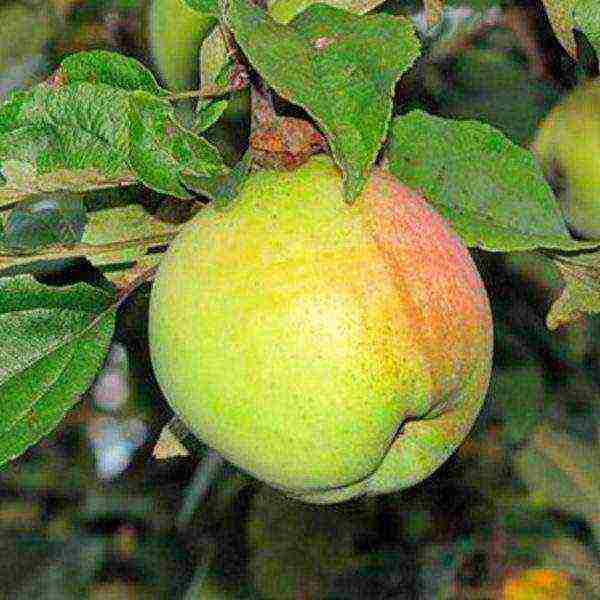
The color of the sour apples of the Belarusian Sinap is characterized by a smooth transition from golden-green to brick-burgundy, and the pulp is characterized by juiciness and tenderness
- The variety Belorusskoe Sweet has an average height and a beautifully drooping crown.
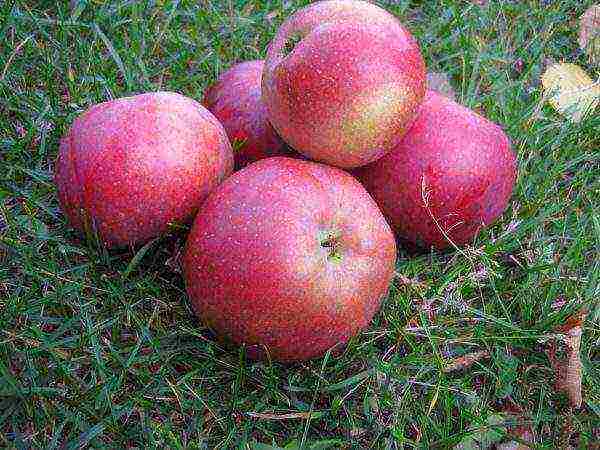
The aromatic sugar apples of the Belarusian Sweet have a beautiful wine-red color and a delicate spicy aroma.
Table: description and characteristics of varieties for Belarus
And also suitable for the weather conditions of Belarus:
- Idared;
- Sinap Orlovsky;
- Festivalnoe;
- Ranet Chernenko;
- Amicable.
Late apple varieties of Ukraine
The following apple varieties will be of interest to Ukrainian gardeners.
- The early winter variety Pepin Saffronny could well be the hero of Russian fairy tales. It is this apple tree, with its relatively low height, that has an amazing wide weeping crown of medium density.
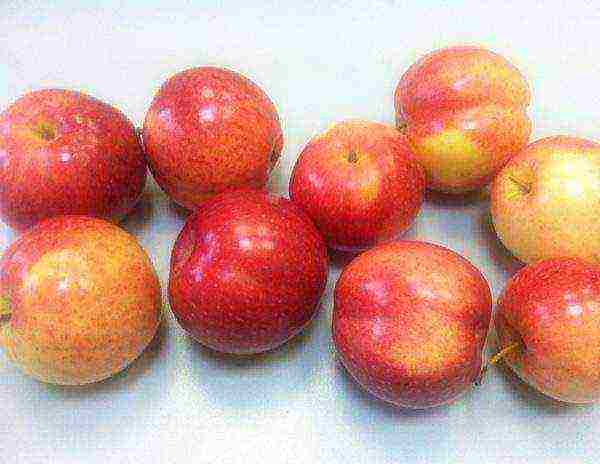
The taste of the fruits of Pepin Saffron is sweet-sugar with a light pleasant aroma, and in color - dark golden with a beautiful wine-red blush
- Student is a medium-sized tree with a rounded crown.

The color of apples of the Studencheskoye variety is carmine-raspberry with indistinct stripes, under the skin there is a pulp with outstanding table qualities
- One of the best commercial varieties, Idared, is good for its weather resistance. The plant itself is of medium height and has a spherical crown.
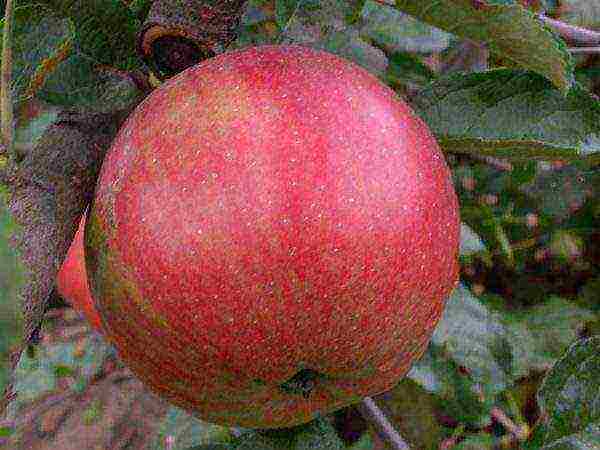
Idared apples have a wine-raspberry color with a pronounced striping and an excellent dessert taste.
- The Renet Simirenko variety is a medium-sized apple tree with a dense rounded crown. Has a high recovery rate.

Renet Simirenko apples, tempting with their appetizing aroma, have a unique sweet-wine taste with a light hint of spice and a yellowish-light green color, with a weak red tan
- The French variety Floriana is not a very tall plant (up to 5 m) with a sparse crown.
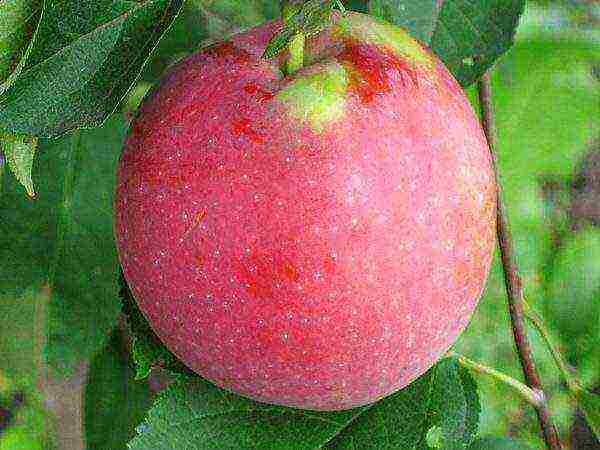
Floriana's golden-green apples are covered with a bright purple blush, decorated with shading, sweet and sour taste
Table: the benefits of fruit trees for Ukrainian orchards
And also in Ukrainian gardens you can grow:
- Lobo;
- Veteran;
- Wesley;
- Star;
- North synap.
Table: top 10 longest shelf life apples
It should be noted that the places in the top are set based on the ratio of the ripening period and the storage period of apples.
Gardeners reviews
There are many late apple trees and every gardener is able to pick up that unique variety that will delight him with its apples right up to spring. Just approach your choice seriously and deliberately, then you will not have any problems with growing fruit trees.
Hello! My name is Olga, I am studying to be an ecologist - soil scientist at the Lomonosov Moscow State University.
